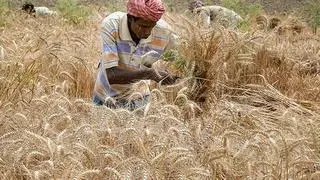New Delhi
A garden pea (matar) variety named ‘Kashi Tripti’ is poised to evolve as a unique snack item, given that it comes with a wholly edible pod which can be savoured raw. Developed by Varanasi-based Indian Institute of Vegetable Research (IIVR), Kashi Tripti has a unique pod with a flavourful taste.
“Our garden pea can be consumed whole. You do not need to peel and extricate the pod. This is suitable as a snack item. Some other universities have also developed such peas suitable for snacks,” T K Behera, director of IIVR told businessline. The pea has been give to the National Seeds Corporation (NSC) for distribution but it is yet to find favour with the farmers who have not yet become aware of its usefullness, Behera added.
Though IIVR is training farmers to raise awareness, the endeavour needs to be upscaled. In some cases, farmers have started growing the pea. But they are still unaware of the edible quality of pod, which contains very low fibre.
In the aftermath of COVID-19 pandemic as demand for functional foods increased, Kashi Tripti has found demand among vegetable seed producing firms. They are selling at 2-3 times more that government set rate of Rs 120/kg, ICAR officials said. Kashi Tripti is a good source of protein and antioxidants that may have potential health benefits, Behera said.
Peas are mainly consumed either as pulse (dry seed) or as vegetables (green seeds), which mainly differ by their starch-sugar ratio. Only 55-60 per cent being the fresh seeds used as vegetables, around 40-45 per cent gets wasted in the form of pod walls. To get the full economic value of the vegetable, agriculture scientists conceived the idea of an edible-podded pea, where the whole pod can be eaten so that it becomes popular among the urban consumers, an IIVR scientist said.
Behera said that edible-podded peas have gained attention in recent years due to their nutritional value and health benefits. But, he agreed that there is a need to make it popular among chefs for its versatility and culinary use in a variety of dishes -- salads, soups and stir-fries.
Some of the popular varieties developed in India are Swarna Tripti, Mithi Phali, Arka Apoorva and Arka Sampoorna, where the pods cane be eaten. But Kashi Tripti offers several advantages including high pod yield and resistance to powdery mildew disease, which is beneficial for farmers. It is a winter-grown crop and requires mild to cool temperatures with an average daytime temperature between 15-21 Degree Celsius and night temperature between 8-10 Degree C for its optimum growth. The average pod yield of Kashi Tripti is between 95 to 100 quintals per hectare in a season.
Kashi Tripti was developed by crossing the parents “Maci Grow” with JP-19, followed by pedigree selection. Special emphasis was put on the traits -- crisp long, broad green pods that are free from parchment layer having slow seed development inside, high pod weight and number.
Kashi Tripti, a mid-season cultivar, takes about 50-56 days to complete 50 per cent flowering and first picking gets ready by 80-85 days after seed sowing. Plants are of medium height (80-90 cm) with one to two primary branches and produces pods that measure 8.2-8.6 cm in length and 1.8-1.9 cm in width, ICAR said in a note. It bears about 12-15 pods per plant with an average weight of 7.1-8.0 gm. The average pod yield is 95-100 quintal/ha that could be harvested in 2 to 3 pickings.
Powdery mildew is major biotic stress throughout the pea-growing regions of India and genetic resistance has been considered most effective strategy of its management. But Kashi Tripti has been found to be resistant to powdery mildew with average disease scale rating between 1.7-2.0.








Comments
Comments have to be in English, and in full sentences. They cannot be abusive or personal. Please abide by our community guidelines for posting your comments.
We have migrated to a new commenting platform. If you are already a registered user of TheHindu Businessline and logged in, you may continue to engage with our articles. If you do not have an account please register and login to post comments. Users can access their older comments by logging into their accounts on Vuukle.